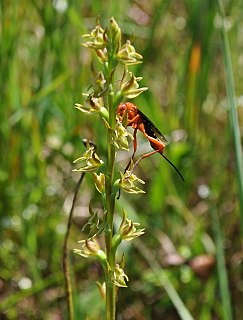Prasophyllum australe, commonly known as the southern leek orchid or austral leek orchid, is a species of orchid and is endemic to south-eastern Australia. It has a single tubular, green leaf and up to fifty scented, greenish-brown flowers with red stripes.

Prasophyllum petilum, commonly known as the Tarengo leek orchid, is a species of orchid endemic to eastern Australia. It has a single tubular, green leaf and up to eighteen pinkish mauve to greenish flowers, well-spaced along a slender flowering stem. It is a small orchid, difficult to locate, generally growing in taller grasses.
Prasophyllum campestre, commonly known as the sandplain leek orchid, or inland leek orchid, is a species of orchid endemic to eastern Australia. It has a single tubular, yellowish-green leaf and up to twenty greenish, strongly scented flowers with red, purplish, brown or white marks. It grows in the drier parts of Queensland, New South Wales and Victoria.

Prasophyllum wilkinsoniorum is a species of orchid endemic to New South Wales. It has a single tubular, bright green leaf and up to forty five scented, dark greenish-brown to brownish-red flowers with a green to pinkish labellum. It grows in grassy places in a restricted area on the Southern Tablelands.

Prasophyllum caudiculum, commonly known as the Guyra leek orchid, is a species of orchid endemic to a small area of northern New South Wales. It has a single tubular, bright green leaf and up to thirty five greenish to reddish-brown flowers crowded along an erect flowering stem. It grows in grassy places near Guyra.
Prasophyllum keltonii, commonly known as Kelton's leek orchid, is a species of orchid endemic to a small region of New South Wales. It has a single tubular, bright green leaf and up to twenty two scented, green, brownish-red or purplish flowers. It is a very rare orchid with only a few hundred plants known.

Prasophyllum maccannii, commonly known as the inland leek orchid, is a species of orchid endemic to Victoria. It has a single tubular green leaf and up to forty green, greenish-pink or brownish flowers. It is found in the central-west of the state, growing in open forest.
Prasophyllum milfordense is a species of orchid endemic to Tasmania. It has a single tubular, dark green leaf and up to thirty greenish-brown, white and purplish flowers. It is a very rare orchid, only found in a single location with a population of around 240 plants.

Prasophyllum solstitium is a species of orchid endemic to the Northern Tablelands of New South Wales. It has a single tubular, bright green leaf and up to thirty five greenish-pink to purplish-red flowers crowded on the flowering stem. It grows in grassland on heavy basalt soil.
Prasophyllum perangustum, commonly known as the Knocklofty leek orchid, is a species of orchid endemic to Tasmania. It has a single tubular, dark green leaf and up to fifteen greenish or light brown flowers with a white labellum. It is a very rare orchid with only six plants recorded in 1993.
Prasophyllum robustum, commonly known as the robust leek orchid, is a species of orchid endemic to Tasmania. It has a single tubular, green leaf and up to thirty greenish-brown flowers with a white labellum. It is only known from a single population of about fifty plants, its numbers having been reduced by land clearing.
Prasophyllum spicatum, commonly known as the dense leek orchid, is a species of orchid endemic to southern mainland Australia. It has a single tubular, green leaf and up to fifty brownish and white or greenish and white flowers crowded in a cylinder-shaped spike.
Prasophyllum stellatum, commonly known as the Ben Lomond leek orchid, is a species of orchid endemic to Tasmania. It has a single tubular, dark green leaf and up to twenty greenish-brown to brownish flowers with a white labellum. It is only known from two disjunct populations, at Ben Lomond and near Deloraine.

Prasophyllum tunbridgense, commonly known as the Tunbridge leek orchid, is a species of orchid endemic to Tasmania. It has a single tubular, bright green leaf and up to twenty five relatively large, green to light greenish-brown flowers with white petals and a large white labellum.

Prasophyllum viretrum is a species of orchid endemic to Victoria. It has a single tubular, dark green leaf and up to thirty five scented, greenish-brown to brownish flowers and is only known from a few small populations in south-western Victoria.
Prasophyllum stygium, commonly known as the elfin leek orchid, is a species of orchid endemic to Victoria. It has a single tube-shaped leaf and up to twenty greenish-brown flowers with a white labellum. It is a recently described plant, previously included with P. fitzgeraldii, but distinguished from that species by its greenish-brown flowers with their white labellum and narrower brown callus. It is only known from a single population of about thirty plants.

Prasophyllum basalticum is a species of orchid endemic to New South Wales. It has a single tubular, dark green leaf and up to fifteen scented, greenish-brown to brownish-red flowers with a white and green labellum. It grows in grassy woodland on the Northern Tablelands.
Prasophyllum graniticola is a species of orchid endemic to New South Wales. It has a single tubular, shiny dark green leaf and up to twenty five scented, greenish to brownish and white flowers. It is only known from two populations on the Northern Tablelands.
Prasophyllum holzingeri is a species of orchid endemic to New South Wales. It has a single tubular, shiny dark green leaf and up to fifteen unscented, greenish to brownish pink and white flowers. It is only known from a few populations in the Barrington Tops area.
Prasophyllum pilligaense is a species of orchid endemic to New South Wales. It has a single tubular, shiny dark green leaf and up to thirty scented greenish brown to brownish and white flowers. It is only known from a few populations in the Coonabarabran district.
















